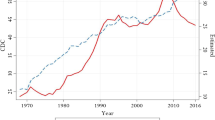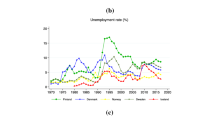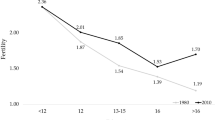Abstract
This study is the first to investigate the economic factors behind the recent rise of the one-child family in the United States. Using longitudinal data from the Panel Study of Income Dynamics (PSID) that runs from 1968 to 2013 and a variety of different model specifications with state and year fixed effect, including logistic regression, linear probability, and Cox proportional hazard models, the study examined the effect of absolute income volatility on the decision of having an only-child family. The study found that an increase in the standard deviation of income is associated with a decrease in the probability of having a second child for mothers who are in the second quartile of income distribution.
Similar content being viewed by others
Notes
According to the Social Security Office of Retirement and Disability Policy (ORDP), in 2035, there will only be enough taxes to pay for 75% of scheduled benefits. The ORDP attributes this imbalance to the drop in the birth rate from 3 to 2 children per woman rather than increasing lifespans. This decrease in the birth rate, if left unchecked, will change the age structure of the US over time. Eventually, it will leave the society with insufficient tax payers to cover the pension and benefits for the retirees who will be collecting social security.
According to the Pew Research Center, the percentage of childless women has increased from 10% in the 1970s to 15% in 2014 while mothers with one child has increased from 10 to 18%. Mothers with two children have increased from 22 to 35%. Mothers with three and four children have decreased from 23 to 20% and from 36 to 12%, respectively.
Becker (1960) stated the following: “An increase in income must increase the amount spent on the average good, but not necessarily that spent on each good. The major exceptions are goods that are inferior members of a broader class, as a Chevrolet is considered an inferior car, margarine an inferior spread, and black bread an inferior bread. Since children do not appear to be inferior members of any broader class, it is likely that a rise in long-run income would increase the amount spent on children” (p. 210).
According to PSID terminology, a Head is designated as a husband in the family unit or a cohabitant with whom the woman has been living for at least 1 year.
All dollar values are in US currency.
References
Ananat, E. O., Gassman-Pines, A., & Gibson-Davis, C. (2013). Community-wide job loss andteenage fertility: Evidence from North Carolina. Demography, 50(6), 2151–2171. https://doi.org/10.1007/s13524-013-0231-3.
Becker, G. S. (1960). An economic analysis of fertility. In Universities National Bureau Committee for Economic Research (Eds.), Demographic and economic change in developed countries (pp. 209–231). Princeton: Princeton University Press.
Becker, G. S., Glaeser, E. L., & Murphy, K. M. (1999). Population and economic growth. The American Economic Review, 89(2), 145–149. https://doi.org/10.1257/aer.89.2.145.
Becker, G. S., & Lewis, H. G. (1973). On the interaction between the quantity and quality of children. Journal of Political Economy, 81(2), S279-S288. Retrieved from http://www.jstor.org/stable/1840425.
Bernardi, L., Klärner, A., & Von der Lippe, H. (2008). Job insecurity and the timing of parenthood: A comparison between Eastern and Western Germany. European Journal of Population, 24(3), 287–313. Retrieved from http://www.jstor.org/stable/40271508.
Borg, M. O. M. (1989). The income-fertility relationship: Effect of the net price of a child. Demography, 26(2), 301–310. Retrieved from http://www.jstor.org/stable/2061527.
Bram, S. (1975). To have or have not: A social psychological study of voluntarily childless couples, parents-to-be, and parents, Unpublished doctoral dissertation, Department of Psychology, University of Michigan, Ann Arbor.
Bureau of Labor Statistics. (2016). CPI Detailed Report Data for April 2016 [Report]. Retrieved from http://www.bls.gov/cpi/cpid1604.pdf.
Butz, W. P., & Ward, M. P. (1979a). The emergence of countercyclical U.S. fertility. The American Economic Review, 69(3), 318–328. Retrieved from http://www.jstor.org/stable/1807367.
Butz, W. P., & Ward, M. P. (1979b). Will US fertility remain low? A new economic interpretation. Population and Development Review, 5(4), 663–688. Retrieved from http://www.jstor.org/stable/1971976.
Conrad, C., Lechner, M., & Werner, W. (1996). East German fertility after unification: Crisis or adaptation? Population and Development Review, 22(2), 331–358. Retrieved from http://www.jstor.org/stable/2137438.
Dynarski, S., Gruber, J., Moffitt, R. A., & Burtless, G. (1997). Can families smooth variable earnings? Brookings Papers on Economic Activity, 1, 229–303. Retrieved from https://EconPapers.repec.org/RePEc:bin:bpeajo:v:28:y:1997:i:1997-1:p:229-303.
Easterlin, R. A. (1976). The conflict between aspirations and resources. Population and Development Review, 2(3–4), 417–425. Retrieved from http://www.jstor.org/stable/1971619.
Fokkema, T., De Valk, H., De Beer, J., & Van Duin, C. (2008). The Netherlands: Childbearing within the context of a “Poldermodel” society. Demographic Research, 19(21), 743–794. https://doi.org/10.4054/DemRes.2008.19.21.
Goldstein, J. R., Sobotka, T., & Jasilioniene, A. (2009). The end of ‘lowest-low’ fertility? Population and Development Review, 35(4), 663–699. Retrieved from http://www.jstor.org/stable/25593682.
Gosselin, P., & Zimmerman, S. (2008). Trends in Income Volatility and Risk, 1970–2004. Retrieved from the Urban Institute website: http://www.urban.org/research/publication/trends-income-volatility-and-risk-1970–2004.
Gottschalk, P., & Moffitt, R. (1994). The growth of earnings instability in the US labor market. Brookings Papers On Economic Activity, 2(25), 217–272. Retrieved from http://www.jstor.org/stable/2534657.
Gottschalk, P., & Moffitt, R. (2007). Trends in Earnings Volatility in the US: 1970–2002. Paper presented to the Annual Meetings of the American Economic Association, Chicago, January 2007.
Haider, S. J. (2001). Earnings instability and earnings inequality of males in the United States: 1967–1991. Journal of Labor Economics, 19(4), 799–836. https://doi.org/10.1086/322821.
Hill, M. (1991). PSID User Guide. Retrieved from https://psidonline.isr.umich.edu/Guide/ug/psidguide.pdf.
Hoem, B. (2000). Entry into motherhood in Sweden: The influence of economic factors on the rise and fall in fertility, 1986–1997. Demographic Research, 2, 4. https://doi.org/10.4054/DemRes.2000.2.4.
Hondroyiannis, G. (2010). Fertility determinants and economic uncertainty: An assessment using European panel data. Journal of Family and Economic Issues, 31(1), 33–50. https://doi.org/10.1007/s10834-009-9178-3.
Houseknecht, S. K. (1977). Wives but not mothers: Factors influencing the decision to remain voluntarily childless (Doctoral dissertation, Pennsylvania State University).
Hymans, S. H., Ackley, G., & Juster, F. T. (1970). Consumer durable spending: explanation and prediction. Brookings Papers on Economic Activity, 2, 173–206. Retrieved from https://www.brookings.edu/bpea-articles/consumer-durable-spending-explanation-and-prediction/.
INE. (2010). Vital Statistics and Basic Demographic Indicators [Press release]. Retrieved from http://www.ine.es/en/prensa/np600_en.pdf.
Kravdal, Ø (2002). The impact of individual and aggregate unemployment on fertility in Norway. Demographic Research, 6(10), 263–294. https://doi.org/10.4054/DemRes.2002.6.10.
Livingston, G. (2014). Birth rates lag in Europe and the U.S., but the desire for kids does not. Retrieved from Pew Research Center website: http://www.pewresearch.org/fact-tank/2014/04/11/birth-rates-lag-in-europe-and-the-u-s-but-the-desire-for-kids-does-not/.
Livingston, G., & Cohn, D. (2010). US birth rate decline linked to recession. Retrieved from Pew Research Center website: http://www.pewsocialtrends.org/2010/04/06/us-birth-rate-decline-linked-torecession/.
Macunovich, D. J. (1996). Relative income and price of time: Exploring their effects on US fertility and female labor force participation. Population and Development Review, 22(Supp.), 223–257. Retrieved from http://www.jstor.org/stable/2808013.
Morgan, S. P., Cumberworth, E., & Wimer, C. (2011). The great recession’s influence on fertility, marriage, divorce, and cohabitation. In D. B. Grusky, B. Western & C. Wimer (Eds.), The great recession (pp. 220–245). New York, NY: Russell Sage Foundation.
Perelli-Harris, B. (2006). The influence of informal work and subjective well-being on childbearing in post-Soviet Russia. Population and Development Review, 32(4), 729–753. Retrieved from http://www.jstor.org/stable/20058925.
Ranjan, P. (1999). Fertility behaviour under income uncertainty. European Journal of Population, 15(1), 25–43. Retrieved from http://www.jstor.org/stable/20164053.
Schmidt, S. R. (1999). Long-run trends in workers’ beliefs about their own job security: Evidence from the general social survey. Journal of Labor Economics, 17(4, pt 2), S127–S141. Retrieved from http://www.jstor.org/stable/10.1086/209945.
Schneider, D. (2015). The great recession, fertility, and uncertainty: Evidence from the United States. Journal Of Marriage And Family, 77(5), 1144–1156. https://doi.org/10.1111/jomf.12212.
Stock, J. H., & Watson, M. W. (2002). Has the business cycle changed and why? NBER Macroeconomics Manual, 17, 159–218. https://doi.org/10.3386/w9127.
Van Giersbergen, N. P. A., & De Beer, J. (1997). Geboorteontwikkeling en consumentenvertrouwen: een econometrische analyse (Birth trends and consumer confidence: An econometric analysis). Maandstatistiek van de Bevolking, 45(11), 23–27. Retrieved from http://library.wur.nl/WebQuery/titel/1008526.
Wang, W., & Morin, R. (2009). Home for the holidays…and every other day. Retrieved from Pew Research Center website: http://pewsocialtrends.org/assets/pdf/home-for-the-holidays.pdf.
Willis, R. J. (1974). Economic theory of fertility behavior. In T. W. Schultz (Ed.), Economics of the family (pp. 25–75). Chicago, IL: University of Chicago Press.
Author information
Authors and Affiliations
Corresponding author
Ethics declarations
Conflict of interest
Fady Mansour declares that he has no conflict of interest.
Human and Animal Rights
This article does not contain any studies with human participants or animals performed by any of the authors.
Additional information
I am indebted to Professors Charles Baum and Michael Roach at Middle Tennessee State University for helpful comments, and would like to thank Professors Joachim Zietz and Jason M. Debacker for comments on an earlier draft.
Rights and permissions
About this article
Cite this article
Mansour, F. Economic Insecurity and Fertility: Does Income Volatility Impact the Decision to Remain a One-Child Family?. J Fam Econ Iss 39, 243–257 (2018). https://doi.org/10.1007/s10834-017-9559-y
Published:
Issue Date:
DOI: https://doi.org/10.1007/s10834-017-9559-y




